Analysis of Developmental Chronology of South Korean Compressed Growth as a Reference from Sustainable Development Perspectives
Abstract
1. Introduction
2. Materials and Methods
2.1. Methodology
2.1.1. Narrative Description and Time-Series Analysis of the Developmental History of South Korea
2.1.2. Comparative Analysis via Referencing South Korean Development in 2015
2.1.3. Latitudinal Map Comparison
2.2. Materials
2.2.1. Economic Indicators
2.2.2. Environmental Indicators
2.2.3. Social Indicators
2.2.4. Political Indicators
2.3. Study Area
3. Results
3.1. Developmental History of South Korea
3.1.1. Economic Development of South Korea
3.1.2. Environmental Development of South Korea
3.1.3. Social Development of South Korea
3.1.4. Political Development of South Korea
3.2. Comparison of Development among MLR Countries as of 2015
3.3. Comparative Latitudinal Maps of Development among MLR Countries as of 2015
4. Discussion
5. Conclusions
Author Contributions
Funding
Institutional Review Board Statement
Informed Consent Statement
Data Availability Statement
Conflicts of Interest
References
- Sachs, J.D. From millennium development goals to sustainable development goals. Lancet 2012, 379, 2206–2211. [Google Scholar] [CrossRef]
- United Nations General Assembly. Transforming our world. In Proceedings of the 2030 Agenda for Sustainable Development, United Nations, New York, NY, USA, 25 September 2015. [Google Scholar]
- Bleischwitz, R.; Spataru, C.; VanDeveer, S.D.; Obersteiner, M.; van der Voet, E.; Johnson, C.; Andrews-Speed, P.; Boersma, T.; Hoff, H.; van Vuuren, D.P. Resource nexus perspectives towards the United Nations Sustainable Development Goals. Nat. Sustain. 2018, 1, 737–743. [Google Scholar] [CrossRef]
- Kiker, G.A.; Bridges, T.S.; Varghese, A.; Seager, T.P.; Linkov, I. Application of Multicriteria Decision Analysis in Environmental Decision Making. Integr. Environ. Assess. Manag. 2005, 1, 95. [Google Scholar] [CrossRef] [PubMed]
- McGowan, P.J.K.; Stewart, G.B.; Long, G.; Grainger, M.J. An imperfect vision of indivisibility in the Sustainable Development Goals. Nat. Sustain. 2019, 2, 43–45. [Google Scholar] [CrossRef]
- Kuznets, P.W. An East Asian Model of Economic Development: Japan, Taiwan, and South Korea. Econ. Dev. Cult. Chang. 1988, 36, S11–S43. [Google Scholar] [CrossRef]
- Minns, J. Of miracles and models: The rise and decline of the developmental state in South Korea. Third World Q. 2001, 22, 1025–1043. [Google Scholar] [CrossRef]
- Krueger, A.O. East Asian Experience and Endogenous Growth Theory. In Growth Theories in Light of the East Asian Experience; Ito, T., Krueger, A.O., Eds.; The University of Chicago Press: Chicago, IL, USA; London, UK, 1995; pp. 9–36. ISBN 0-226-38670-8. [Google Scholar]
- Birdsall, N.M.; Campos, J.E.L.; Kim, C.S.; Corden, W.M.; MacDonald, L. The East Asian Miracle: Economic Growth and Public Policy: Main Report; Oxford University Press: Oxford, UK, 1993; ISBN 0195209931. [Google Scholar]
- Choi, Y.J.; Cho, Y.M.; Park, C.K.; Jang, H.C.; Park, K.S.; Kim, S.Y.; Lee, H.K. Rapidly increasing diabetes-related mortality with socio-environmental changes in South Korea during the last two decades. Diabetes Res. Clin. Pract. 2006, 74, 295–300. [Google Scholar] [CrossRef]
- Palley, H.A. Social Policy and the Elderly in South Korea: Confucianism, Modernization, and Development. Asian Surv. 1992, 32, 787–801. [Google Scholar] [CrossRef]
- Sorensen, C.W. Success and Education in South Korea. Comp. Educ. Rev. 1994, 38, 10–35. [Google Scholar] [CrossRef]
- Yang, S.; Khang, Y.H.; Harper, S.; Davey Smith, G.; Leon, D.A.; Lynch, J. Understanding the rapid increase in life expectancy in South Korea. Am. J. Public Health 2010, 100, 896–903. [Google Scholar] [CrossRef]
- Rockström, J.; Sukhdev, P. How Food Connects All the SDGs. Available online: https://www.stockholmresilience.org/research/research-news/2016-06-14-how-food-connects-all-the-sdgs.html (accessed on 30 March 2020).
- ECLAC; OECD. Emerging Challenges and Shifting Paradigms: New Perspectives on International Cooperation for Development; Economic Commission for Latin America and the Caribbean (ECLAC)/Organisation for Economic Cooperation and Development (LC/PUB.2018/16); United Nations: Santiago, Chile, 2018. [Google Scholar]
- Kemp, R.; Loorbach, D.; Rotmans, J. Transition management as a model for managing processes of co-evolution towards sustainable development. Int. J. Sustain. Dev. World 2007, 14, 78–91. [Google Scholar] [CrossRef]
- Geels, F.W. Technological transitions as evolutionary reconfiguration processes: A multi-level perspective and a case-study. Res. Policy 2002, 31, 1257–1274. [Google Scholar] [CrossRef]
- Jenks, F.G. The Data Model Concept in Statistical Mapping. Int. Yearb. Cartogr. 1967, 7, 186–190. [Google Scholar]
- World Bank. Air Transport, Registered Carrier Departures Worldwide. Available online: https://data.worldbank.org/indicator/IS.AIR.DPRT (accessed on 30 March 2020).
- Zhang, F.; Graham, D.J. Air transport and economic growth: A review of the impact mechanism and causal relationships. Transp. Rev. 2020, 40, 1–23. [Google Scholar] [CrossRef]
- Button, K.; Taylor, S. International air transportation and economic development. J. Air Transp. 2000, 6, 209–222. [Google Scholar] [CrossRef]
- World Bank. Electric Power Consumption (kWh per Capita). Available online: https://data.worldbank.org/indicator/EG.USE.ELEC.KH.PC (accessed on 30 March 2020).
- Ferguson, R.; Wilkinson, W.; Hill, R. Electricity use and economic development. Energy Policy 2000, 28, 923–934. [Google Scholar] [CrossRef]
- Kasperowicz, R. Electricity consumption and economic growth: Evidence from Poland. J. Int. Stud. 2014, 7. [Google Scholar] [CrossRef] [PubMed]
- Hirsh, R.F.; Koomey, J.G. Electricity consumption and economic growth: A new relationship with significant consequences? Electr. J. 2015, 28, 72–84. [Google Scholar] [CrossRef]
- International Labour Office. Employment-to-Population Ratio-ILO Modelled Estimates. Available online: https://www.ilo.org/ilostat/faces/oracle/webcenter/portalapp/pagehierarchy/Page33.jspx;ILOSTATCOOKIE=GgkqbmOfklrVSG_CmXQ5PeE7wV6ECz-kcDvvCssUcp-YiVsmP5cd!-1102363596?locale=EN&MBI_ID=7&_adf.ctrl-state=1b62a5xg4u_50&_afrLoop=10542516107271835&_afrWindowMod (accessed on 30 March 2020).
- World Bank. Electricity Production from Renewable Sources, Excluding Hydroelectric (% of Total). Available online: https://data.worldbank.org/indicator/EG.ELC.RNWX.ZS (accessed on 30 March 2020).
- Stiglitz, J.E.; Sen, A.; Fitoussi, J.P. Report by the Commission on the Measurement of Economic Performance and Social Progress; Commission on the Measurement of Economic Performance and Social Progress (CMEPSP): Paris, France, 2009.
- Cohen, A.J.; Brauer, M.; Burnett, R.; Anderson, H.R.; Frostad, J.; Estep, K.; Balakrishnan, K.; Brunekreef, B.; Dandona, L.; Dandona, R.; et al. Estimates and 25-year trends of the global burden of disease attributable to ambient air pollution: An analysis of data from the Global Burden of Diseases Study 2015. Lancet 2017, 389, 1907–1918. [Google Scholar] [CrossRef]
- Klein Goldewijk, K.; Beusen, A.; van Drecht, G.; de Vos, M. The HYDE 3.1 spatially explicit database of human-induced global land-use change over the past 12,000 years. Glob. Ecol. Biogeogr. 2011, 20, 73–86. [Google Scholar] [CrossRef]
- Alkemade, R.; van Oorschot, M.; Miles, L.; Nellemann, C.; Bakkenes, M.; ten Brink, B. GLOBIO3: A framework to investigate options for reducing global terrestrial biodiversity loss. Ecosystems 2009, 12, 374–390. [Google Scholar] [CrossRef]
- Convention on Biological Diversity. Decision VII/30: Strategic Plan: Future Evaluation of Progress. 2004. Available online: https://www.cbd.int/decision/cop/?id=7767 (accessed on 10 July 2019).
- World Bank. CO2 Emissions (kt). Available online: https://data.worldbank.org/indicator/EN.ATM.CO2E.KT (accessed on 30 March 2020).
- World Bank. Forest Area (% of Land Area). Available online: https://data.worldbank.org/indicator/AG.LND.FRST.ZS (accessed on 30 March 2020).
- World Bank. GDP (Current US$). Available online: https://data.worldbank.org/indicator/NY.GDP.MKTP.CD (accessed on 30 March 2020).
- van Leeuwen, B.; van Leeuwen-Li, J. Average Years of Education, IISH Data Collection, V1. Available online: https://hdl.handle.net/10622/KCBMKI (accessed on 30 March 2020).
- UNDP. Human Development Data (1990–2018). Available online: http://hdr.undp.org/en/data# (accessed on 30 March 2020).
- Inter-Parliamentary Union. Compare Data on Parliaments: Percentage of Women. Available online: https://data.ipu.org/compare?field=country%3A%3Afield_structure_of_parliament#map (accessed on 30 March 2020).
- World Bank. Life Expectancy at Birth, Total (Years). Available online: https://data.worldbank.org/indicator/sp.dyn.le00.in (accessed on 31 March 2020).
- van Leeuwen, B.; van Leeuwen-Li, J. Educational Inequality Gini Coefficient, IISH Data Collection, V1. Available online: https://hdl.handle.net/10622/KORKQW (accessed on 30 March 2020).
- Bettencourt, L.M.; Lobo, J.; Helbing, D.; Kühnert, C.; West, G.B. Growth, innovation, scaling, and the pace of life in cities. Proc. Natl. Acad. Sci. USA 2007, 104, 7301–7306. [Google Scholar] [CrossRef] [PubMed]
- UNDESA. World Urbanization Prospects: The 2018 Revision; United Nations: New York, NY, USA, 2019. [Google Scholar]
- Transparency International. Corruption Perceptions Index 2017. Available online: https://www.transparency.org/news/feature/corruption_perceptions_index_2017 (accessed on 30 March 2020).
- Coppedge, M.; Gerring, J.; Henrik Knutsen, C.; Lind-berg, S.I.; Skaaning, S.E.; Teorell, J.; Altman, D.; Bernhard, M.; Cornell, A.; Steven Fish, M.; et al. V-Dem Dataset v8, Varieties of Democracy (V-Dem) Project; Department of Political Science, University of Gothenburg: Gothenburg, Sweden, 2018. [Google Scholar] [CrossRef]
- Pemstein, D.; Marquardt, K.L.; Tzelgov, E.; Wang, Y.; Krusell, J.; Miri, F. The V-Dem Measurement Model: Latent Variable Analysis for Cross-National and Cross-Temporal Expert-Coded Data. V-Dem Work. Pap. 2018, 21. [Google Scholar] [CrossRef]
- Stockholm International Peace Research Institute. SIPRI Military Expenditure Database. Available online: https://www.sipri.org/databases/milex (accessed on 30 March 2020).
- Brauner, J. Military spending and democracy. Def. Peace Econ. 2015, 26, 409–423. [Google Scholar] [CrossRef]
- Töngür, Ü.; Hsu, S.; Elveren, A.Y. Military expenditures and political regimes: Evidence from global data, 1963–2000. Econ. Model. 2015, 44, 68–79. [Google Scholar] [CrossRef]
- Ahlström, A.; Raupach, M.R.; Schurgers, G.; Smith, B.; Arneth, A.; Jung, M.; Reichstein, M.; Canadell, J.G.; Friedlingstein, P.; Jain, A.K.; et al. The dominant role of semi-arid ecosystems in the trend and variability of the land CO2 sink. Science 2015, 348, 895–899. [Google Scholar] [CrossRef] [PubMed]
- Chen, Y.; Tang, H. Desertification in north China: Background, anthropogenic impacts and failures in combating it. Land Degrad. Dev. 2005, 16, 367–376. [Google Scholar] [CrossRef]
- Kafatos, M.C.; Kim, S.H.; Lim, C.H.; Kim, J.; Lee, W.K. Responses of Agroecosystems to Climate Change: Specifics of Resilience in the Mid-Latitude Region. Sustainability 2017, 9, 1361. [Google Scholar] [CrossRef]
- Kummu, M.; Varis, O. The world by latitudes: A global analysis of human population, development level and environment across the north-south axis over the past half century. Appl. Geogr. 2011, 31, 495–507. [Google Scholar] [CrossRef]
- Lee, W.K.; Shvidenko, A.; Kraxner, F.; Son, Y.; Jeon, S.W.; Moon, J.Y. Carbon Science Economics Convergence Research for Mid-Latitude Ecotone: Carbon Science Economics Convergence Research for Mid-Latitude Ecotone. No North without South, no South without North: The urgent need for an integrated view on global forests. In Proceedings of the XIV World Forestry Congress, World Forestry Congress 2015, Durban, South Africa, 10 September 2015; Volume 12. [Google Scholar]
- Meersmans, J.; Arrouays, D.; van Rompaey, A.J.J.; Pagé, C.; de Baets, S.; Quine, T.A. Future C loss in mid-latitude mineral soils: Climate change exceeds land use mitigation potential in France. Sci. Rep. 2016, 6, 1–11. [Google Scholar] [CrossRef]
- Norris, J.R.; Allen, R.J.; Evan, A.T.; Zelinka, M.D.; O’Dell, C.W.; Klein, S.A. Evidence for climate change in the satellite cloud record. Nature 2016, 536, 72–75. [Google Scholar] [CrossRef] [PubMed]
- Sachs, J.; Schmidt-Traub, G.; Kroll, C.; Durand-Delacre, D.; Teksoz, K. SDG Index and Dashboards Report 2017; Bertelsmann Stiftung and Sustainable Development Solutions Network (SDSN): New York, NY, USA, 2017. [Google Scholar]
- Song, C.; Kim, S.J.; Moon, J.; Lee, S.J.; Lee, W.; Kim, N.; Wang, S.W.; Lee, W.K. Classification of Global Land Development Phases by Forest and GDP Changes for Appropriate Land Management in the Mid-Latitude. Sustainability 2017, 9, 1342. [Google Scholar] [CrossRef]
- CEIC. South Korea GDP per Capita (1953–2020). Available online: https://www.ceicdata.com/en/indicator/korea/gdp-per-capita (accessed on 30 March 2020).
- Kim, J. Aid and state transition in Ghana and South Korea. Third World Q. 2015, 36, 1333–1348. [Google Scholar] [CrossRef]
- Lee, Y. From an ODA-dependent country to a donor: Korea’s ODA experience and its implication for Lao development. J. Contemp. Korean Stud. 2015, 2, 153–178. [Google Scholar]
- Coy, J.; Poley, J.; Schunka, A. Migrations in the German Lands, 1500–2000; Berghahn Books: New York, NY, USA, 2016; ISBN 978-1-78533-144-2. [Google Scholar]
- Hong, I. South Korea Country Report; INTERACT Research Report 2014/07; European University Institute: San Domenico di Fiesole, Italy, 2014. [Google Scholar]
- FAO. Integrated Policy for Forests, Food Security and Sustainable Livelihoods: Lessons from the Republic of Korea; Food and Agriculture Organization of the United Nations (FAO): Rome, Italy, 2016. [Google Scholar]
- Horikane, Y. The political economy of heavy industrialization: The heavy and chemical industry (HCI) push in South Korea in the 1970s. Mod. Asian Stud. 2005, 39, 369–397. [Google Scholar] [CrossRef]
- Kim, S.Y. Consolidating the authoritarian developmental state in the 1970s Korea: Chosen strategies. Int. Rev. Public Adm. 2007, 12, 119–132. [Google Scholar] [CrossRef]
- Kim, S.K.; Finch, J. Living with Rhetoric, Living against Rhetoric: Korean Families and the IMF Economic Crisis. Korean Stud. 2002, 26, 120–139. [Google Scholar] [CrossRef]
- Igbafen, M.L. South Korea’s Development Experience as an Aid Recipient: Lessons for Sub-Saharan Africa. In The South Korean Development Experience: Beyond Aid; Kim, E.M., Kim, P.H., Eds.; Palgrave Macmillan: London, UK, 2014; pp. 111–135. ISBN 978-1-349-44753-4. [Google Scholar]
- OECD. DAC Members’ Net ODA in 2018. Available online: http://www.oecd.org/dac/financing-sustainable-development/development-finance-data/ (accessed on 30 March 2020).
- Forest Stewardship Council. Centralized National Risk Assessment for Republic of Korea; FSC International Center: Bonn, Germany, 2017. [Google Scholar]
- Korea Forest Service. Leveraging Public Programmes with Socio-Economic and Development Objectives to Support Conservation and Restoration of Ecosystems: Lessons Learned from the Republic of Korea’s National Reforestation Programme; Korea Forest Service: Daejeon, Korea, 2014.
- Korea Forest Service. Forestry Education. Available online: https://www.forest.go.kr/newkfsweb/html/HtmlPage.do?pg=/foreston/fon_culture/UI_KFS_1001_050203.html&orgId=fon&mn=KFS_01_13_03_06_02 (accessed on 30 March 2020).
- Kim, G.S.; Lim, C.H.; Kim, S.; Lee, J.; Son, Y.; Lee, W.K. Effect of National-Scale Afforestation on Forest Water Supply and Soil Loss in South Korea, 1971–2010. Sustainability 2017, 9, 1017. [Google Scholar] [CrossRef]
- Kim, S.J.; Lim, C.H.; Kim, G.S.; Lee, J.; Geiger, T.; Rahmati, O.; Son, Y.; Lee, W.K. Multi-Temporal Analysis of Forest Fire Probability Using Socio-Economic and Environmental Variables. Remote Sens. 2019, 11, 86. [Google Scholar] [CrossRef]
- Korea Forest Service. Forest Basic Statistics 2015; Korea Forest Service: Daejeon, Korea, 2016.
- Lim, C.H.; Kim, Y.S.; Won, M.; Kim, S.J.; Lee, W.K. Can satellite-based data substitute for surveyed data to predict the spatial probability of forest fire? A geostatistical approach to forest fire in the Republic of Korea. Geomat. Nat. Hazards Risk 2019, 10, 719–739. [Google Scholar] [CrossRef]
- Brown, L.R. Plan B: Rescuing a Planet under Stress and a Civilization in Trouble; WW Norton & Company: New York, NY, USA; London, UK, 2003; ISBN 978-0393325232. [Google Scholar]
- Noronha, R. Why is it so difficult to grow fuelwood? Unasylva 1981, 33, 4–13. [Google Scholar]
- Ministry of Environment. National Survey on Public Attitudes towards the Environmental Preservation; Research & Research, Inc.: Seoul, Korera, 2014.
- Lodge, G.C.; Vogel, E.F. Ideology and National Competitiveness: An Analysis of Nine Countries; Harvard Business School Press: Boston MA, USA, 1987. [Google Scholar]
- Korea Environment Institute. 2017 Public Attitudes towards the Environment. KEI Focus 2018, 33, 6-3. [Google Scholar]
- Lee, M.S. Korean Social Trends 2016: Public Awareness and Attitude toward the Environment; Statistics Research Institute: Daejeon, Korea, 2016.
- World Bank. PM2.5 Air Pollution, Mean Annual Exposure (Micrograms per Cubic Meter). Available online: https://data.worldbank.org/indicator/EN.ATM.PM25.MC.M3 (accessed on 30 March 2020).
- Kim, D.S. Air Pollution History, Regulatory Changes, and Remedial Measures of the Current Regulatory Regimes in Korea. J. Korean Soc. Atmos. 2013, 29, 353–368. [Google Scholar] [CrossRef]
- National Institute of Environmental Research. Annual Report of Air Quality in Korea 2017; National Institute of Environmental Research (NIER): Incheon, Korea, 2018.
- National Institute of Environmental Research. Emissions by Substance. Available online: https://airemiss.nier.go.kr/mbshome/mbs/airemiss/index.do (accessed on 30 March 2020).
- Park, S.; Kim, S.J.; Yu, H.; Lim, C.H.; Park, E.; Kim, J.; Lee, W.K. Developing an Adaptive Pathway to Mitigate Air Pollution Risk for Vulnerable Groups in South Korea. Sustainability 2020, 12, 1790. [Google Scholar] [CrossRef]
- World Health Organization. 9 Out of 10 People Worldwide Breathe Polluted Air, but More Countries are Taking Action. WHO Newsroom. 2 May 2018. Available online: https://www.who.int/news/item/02-05-2018-9-out-of-10-people-worldwide-breathe-polluted-air-but-more-countries-are-taking-action (accessed on 1 August 2019).
- Chung, U.; Choi, J.; Yun, J.I. Urbanization effect on the observed change in mean monthly temperatures between 1951-1980 and 1971-2000 in Korea. Clim. Chang. 2004, 66, 127–136. [Google Scholar] [CrossRef]
- Kang, L. South Korea’s sustainable urban planning and environmental technology. Discussions 2014, 10, 1. [Google Scholar]
- Ministry for Education and Employment. A National Literacy Strategy for All in Malta and Gozo 2014–2019; Ministry for Education and Employment of Government of Malta: Floriana, Malta, 2014.
- UNESCO Institute for Statistics. The Next Generation of Literacy Statistics: Implementing the Literacy Assessment and Monitoring Programme (LAMP); UNESCO Institute for Statistics (UNESCO-UIS): Montreal, QC, Canada, 2009. [Google Scholar]
- Yi, C.; Kim, S.; Adams, D.K. Sixty Years of Korean Education; Seoul National University Press: Seoul, Korea, 2010; ISBN 8952111796. [Google Scholar]
- International Labour Office. A Skilled Workforce for Strong, Sustainable and Balanced Growth: A G20 Training Strategy; International Labour Office (ILO): Geneva, Switzerland, 2011. [Google Scholar]
- Kim, D.I.; Topel, R.H. Labor Markets and Economic Growth: Lessons from Korea’s Industrialization, 1970–1990. In Differences and Changes in Wage Structures; Freeman, R.B., Katz, L.F., Eds.; University of Chicago Press: Chicago, IL, USA, 1995; pp. 227–264. ISBN 0-226-26160-3. [Google Scholar]
- Seth, M.J. Education Fever: Society, Politics, and the Pursuit of Schooling in South Korea; University of Hawaii Press: Honolulu, HI, USA, 2002; ISBN 9780824862305. [Google Scholar]
- World Bank. Proportion of Seats Held by Women in National Parliaments (%). Available online: https://data.worldbank.org/indicator/SG.GEN.PARL.ZS (accessed on 30 March 2020).
- Kang, M. The Korean Business Conglomerate: Chaebol Then and Now. Korea Res. Monogr. 1996, 21, 457. [Google Scholar]
- Park, K.A. Women and Development: The Case of South Korea. Comp. Politics 1993, 25, 127–145. [Google Scholar] [CrossRef]
- Jang, H.J. Summary and Evaluation of 50 Years of Working Women; Discussion on the Basic Direction of Working Women’s Policy in the 21st Century; Korean Women’s Development Institute: Seoul, Korea, 2001; pp. 75–125. [Google Scholar]
- Statistics Korea. The Changes in Korean Society in Statistics after the 70th Anniversary of the Independence I (Explanation); Human Culture Arirang: Seoul, Korea, 2015; ISBN 9791155656839.
- UNRISD Economic and Social Development in the Republic of Korea: Processes; Institutions and Actors, Research and Policy Brief 14; UNRISD: Geneva, Switzerland, 2012.
- Statistics Korea. Female Economically Active Population and Participation Rate. Available online: http://www.index.go.kr/potal/main/EachDtlPageDetail.do?idx_cd=1572 (accessed on 31 March 2020).
- Statistics Korea. Female to Male Wage Ratio. Available online: http://www.index.go.kr/potal/main/EachDtlPageDetail.do?idx_cd=2714 (accessed on 31 March 2020).
- OECD. Fertility Rates (Indicator). Available online: https://data.oecd.org/pop/fertility-rates (accessed on 31 March 2020). [CrossRef]
- OECD. Gender Wage Gap (Indicator). Available online: http://www.oecd-ilibrary.org/employment/gender-wage-gap/indicator/english_7cee77aa-en (accessed on 31 March 2020). [CrossRef]
- Koh, E. Gender issues and Confucian scriptures: Is Confucianism incompatible with gender equality in South Korea? Bull. Sch. Orient Afr. Stud. 2008, 71, 345–362. [Google Scholar] [CrossRef]
- Soh, E. Ten years’ experience of gender quota system in Korean politics. Gend. Equal. Multicult. Conviv. Age Glob. 2011, 98, 98–104. [Google Scholar]
- Statistics Korea. Percentage of Female Parliamentarians. Available online: http://www.index.go.kr/potal/stts/idxMain/selectPoSttsIdxSearch.do?idx_cd=4064&stts_cd=406403 (accessed on 31 March 2020).
- Anderson, G.F. Universal health care coverage in Korea. Health Aff. 1989, 8, 24–34. [Google Scholar] [CrossRef] [PubMed]
- National Health Insurance Service. National Health Insurance System of Korea; National Health Insurance Service: Wonju, Korea, 2015. [Google Scholar]
- Kwon, S. South Korean Health Policy and Universal Health Coverage. In Secrets of an Economic Miracle: Lessons for Sustainable Development from South Korea; Kim, T., Young, S., Eds.; KDI School of Public Policy and Management: Sejong, Korea, 2019; ISBN 979-11-5545-189-2. [Google Scholar]
- World Bank. School Enrollment, Tertiary (% Gross). Available online: https://data.worldbank.org/indicator/SE.TER.ENRR (accessed on 30 March 2020).
- Croissant, A. Electoral Politics in South Korea. In Electoral Politics in Southeast & East Asia; Croissant, A., Bruns, G., John, M., Eds.; Friedrich-Ebert-Stiftung: Singapore, 2002; pp. 233–276. ISBN 981-04-6020-1. [Google Scholar]
- Kang, D.C. Bad loans to good friends: Money politics and the developmental state in South Korea. Int. Organ. 2002, 56, 177–207. [Google Scholar] [CrossRef]
- Rhee, T.C. South Korea’s Economic Development and its Socio-Political Impact. Asian Surv. 1973, 13, 677–690. [Google Scholar] [CrossRef]
- Cotton, J. Understanding the State in South Korea. Comp. Political Stud. 1992, 24, 512–531. [Google Scholar] [CrossRef]
- Lee, S.H. Transitional Politics of Korea, 1987–1992: Activation of Civil Society. Pac. Aff. 1993, 66, 351. [Google Scholar] [CrossRef]
- Saxer, C.J. From Transition to Power Alternation: Democracy in South Korea, 1987–1997; Routledge: London, UK, 2013. [Google Scholar]
- Doucette, J. The Occult of Personality: Korea’s Candlelight Protests and the Impeachment of Park Geun-hye. J. Asian Stud. 2017, 76, 851–860. [Google Scholar] [CrossRef]
- Lee, S.H. Political transfiguration and the reinvented popular masses: A sociological study into the “Candlelight Struggle” in South Korea in 2016–17. Sociétés 2017, 138, 85–97. [Google Scholar] [CrossRef]
- Kim, D.J. The Once and Future Korea. Foreign Policy 1992, 40–55. [Google Scholar] [CrossRef]
- Moon, M. International News Coverage of the Korean Conflict. In International News Coverage and the Korean Conflict: The Challenges of Reporting Practices; Moon, M., Ed.; Palgrave Macmillan: Singapore, 2019; pp. 111–127. ISBN 978-981-13-6290-3. [Google Scholar]
- Kim, Y. Old narratives in new times: Representations of North Korea and unification in South Korean social studies textbooks. Comp. J. Comp. Int. Educ. 2019, 1–18. [Google Scholar] [CrossRef]
- Roberts, T. An Analysis of Inter-Korean Relations and Sports Diplomacy Leading Up to, during and Following the 2018 Pyeongchang Winter Olympics in South Korea. Master’s Thesis, Leiden University, Leiden, The Netherlands, 2019. [Google Scholar]
- Friedman, B.M. The Moral Consequences of Economic Growth; Vintage Books: New York, NY, USA, 2006; ISBN 9781400095711. [Google Scholar]
- Ministry of Foreign Affairs. 2015 Diplomatic White Paper; Ministry of Foreign Affairs: Seoul, Korea, 2015.
- OECD. Labour Force Participation Rate by Sex, 15+, 15–64 and 15–24 Years Old. Available online: http://www.oecd.org/gender/data/labour-force-participation-by-sex-age.htm (accessed on 31 March 2020).
- Shin, K.Y. A new approach to social inequality: Inequality of income and wealth in South Korea. J. Chin. Sociol. 2020, 7, 1–15. [Google Scholar] [CrossRef]
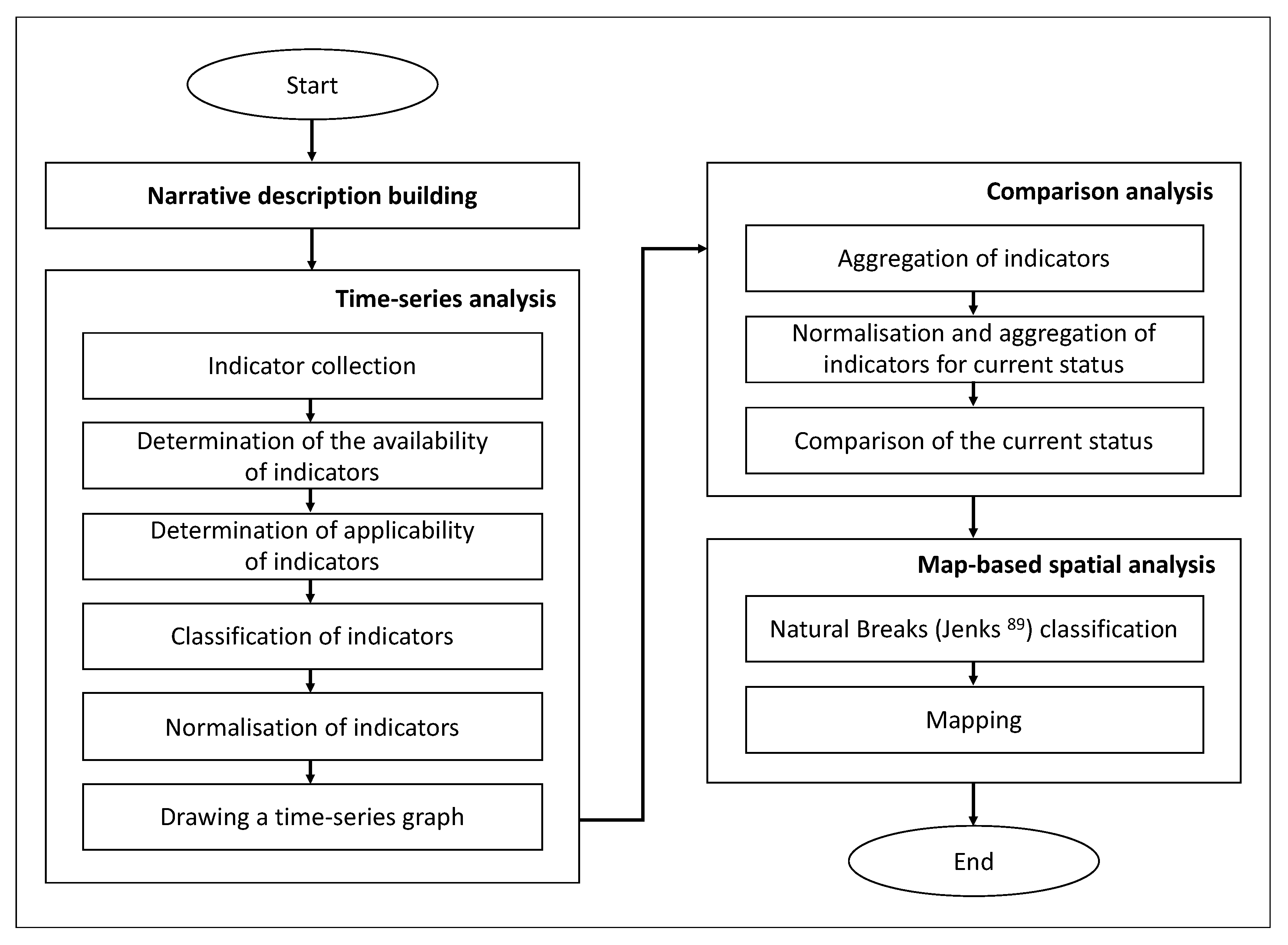

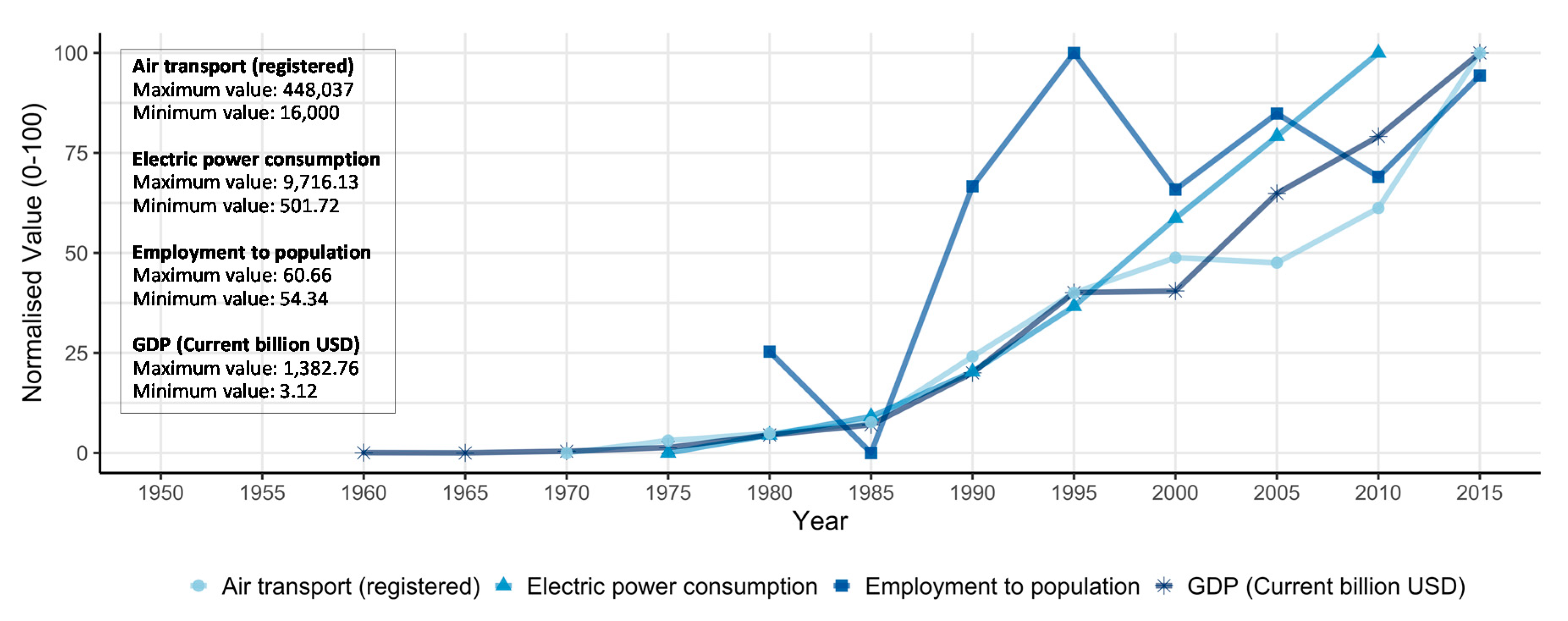

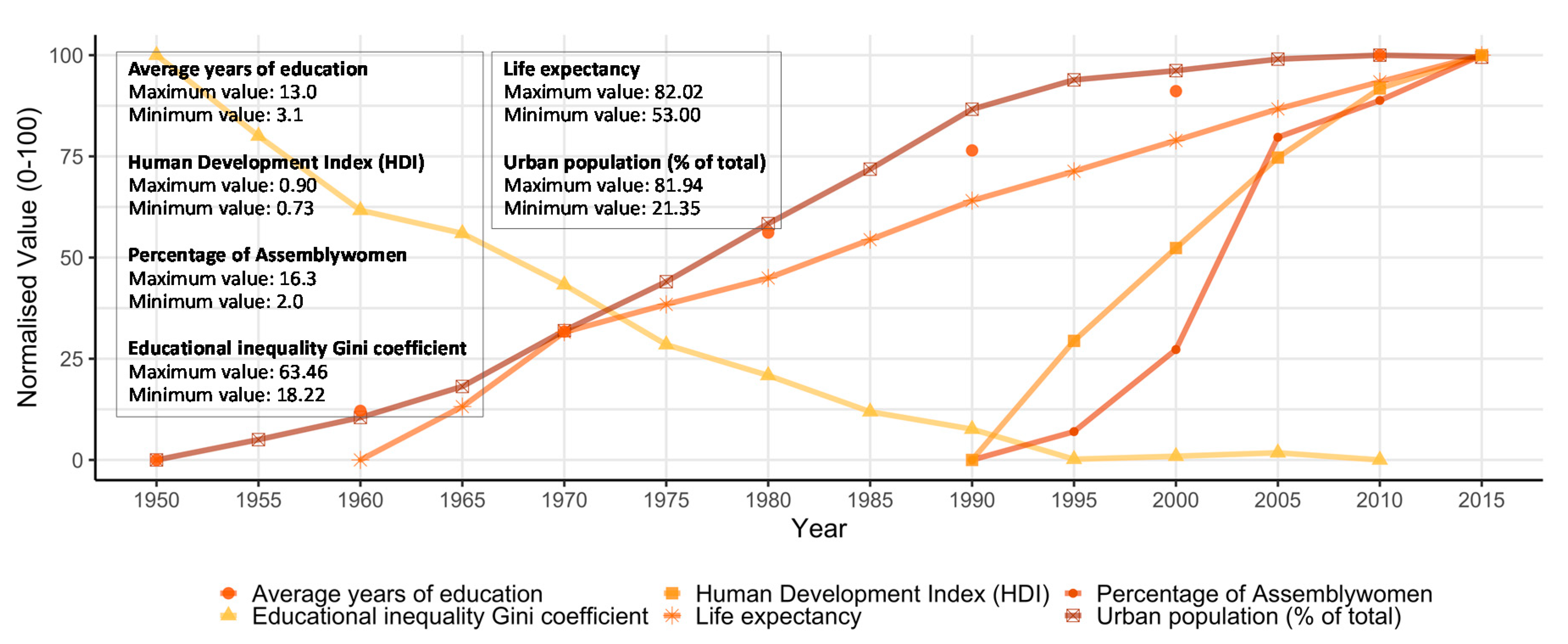
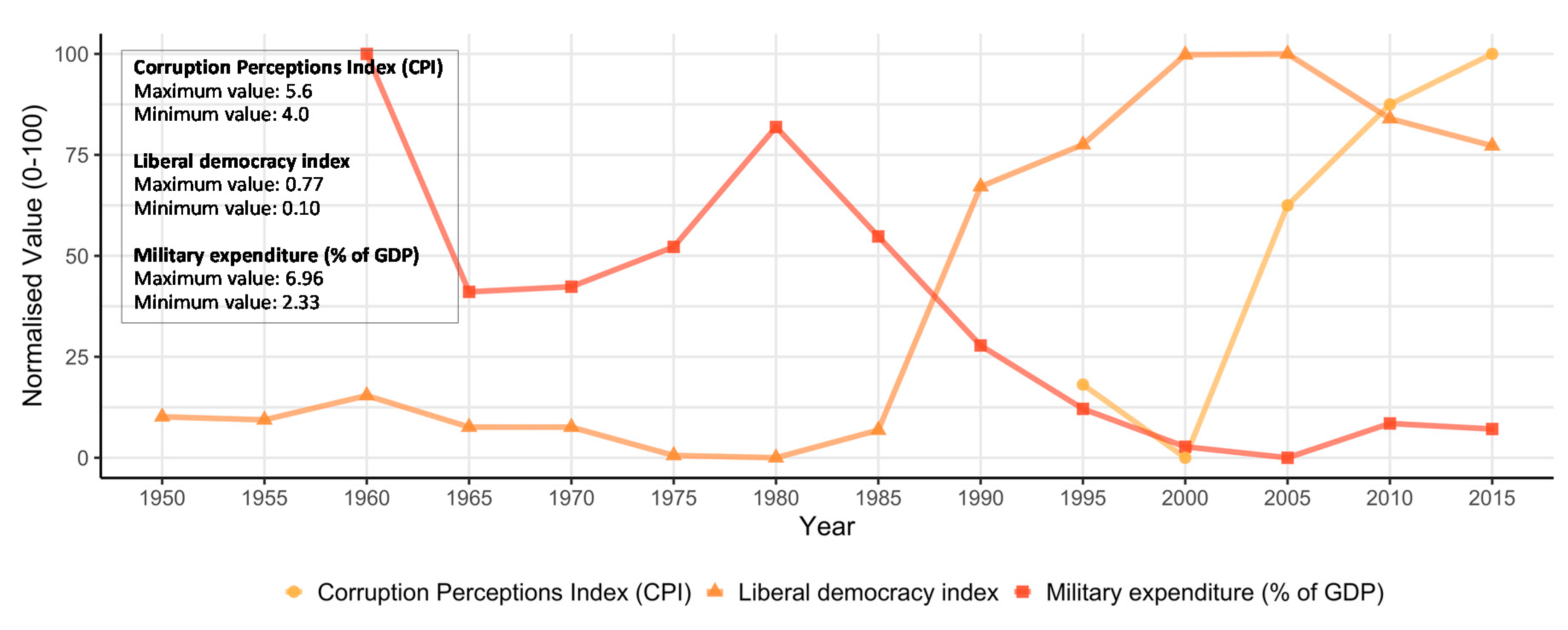


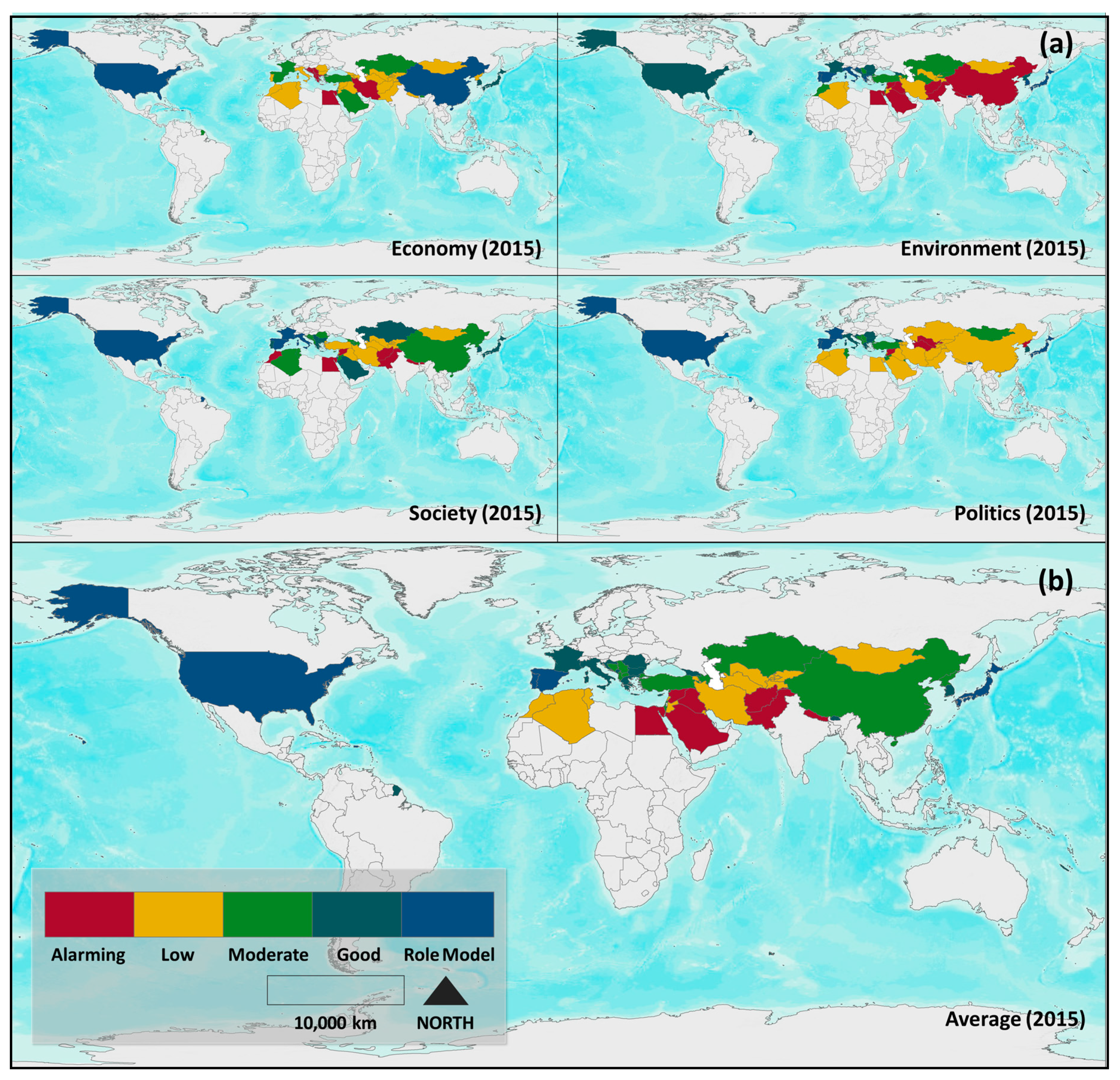
| Sector | Indicator | Unit | Source |
|---|---|---|---|
| Economic development | Air transport (registered) | - | World Bank |
| Electric power consumption | kWh per capita | World Bank | |
| Employment-to-population ratio | % | International Labour Organisation | |
| GDP | Current billion USD | World Bank | |
| Environmental development | PM2.5 air pollution, mean annual exposure | μg/m3 | World Bank |
| Biodiversity | - | Clio | |
| CO2 emissions | kt | World Bank | |
| Electricity production from renewable sources, excluding hydroelectricity | % of total | World Bank | |
| Forest area | % of land | World Bank | |
| Social development | Average years of education | year(s) | Clio |
| HDI | - | United Nations Development Programme | |
| Percentage of assemblywomen | % | World Bank | |
| Educational inequality Gini coefficient | % | Clio | |
| Life expectancy | year(s) | World Bank | |
| Urban population | % of total | UN Department of Social and Economic Affairs | |
| Political development | CPI | - | Transparency International |
| LDI | - | V-Dem | |
| Military expenditure | % of GDP | SIPRI |
| Abbreviation | Country | Abbreviation | Country |
|---|---|---|---|
| Afghanistan | AFG | South Korea | KOR |
| Albania | ALB | Kuwait | KWT |
| Algeria | DZA | Kyrgyzstan | KGZ |
| Armenia | ARM | Lebanon | LBN |
| Azerbaijan | AZE | Macedonia | MKD |
| Bhutan | BTN | Malta | MLT |
| Bosnia and Herzegovina | BIH | Mongolia | MNG |
| Bulgaria | BGR | Montenegro | MNE |
| China | CHN | Morocco | MAR |
| Croatia | HRV | Nepal | NPL |
| Cyprus | CYP | Pakistan | PAK |
| Egypt | EGY | Portugal | PRT |
| France | FRA | Romania | ROU |
| Georgia | GEO | Saudi Arabia | SAU |
| Greece | GRC | Serbia | SRB |
| Iran | IRN | Spain | ESP |
| Iraq | IRQ | Syria | SYR |
| Israel | ISR | Tajikistan | TJK |
| Italy | ITA | Tunisia | TUN |
| Japan | JPN | Turkey | TUR |
| Jordan | JOR | Turkmenistan | TKM |
| Kazakhstan | KAZ | United States | USA |
| North Korea | PRK | Uzbekistan | UZB |
Publisher’s Note: MDPI stays neutral with regard to jurisdictional claims in published maps and institutional affiliations. |
© 2021 by the authors. Licensee MDPI, Basel, Switzerland. This article is an open access article distributed under the terms and conditions of the Creative Commons Attribution (CC BY) license (http://creativecommons.org/licenses/by/4.0/).
Share and Cite
Kim, S.J.; Lee, W.-K.; Ahn, J.Y.; Lee, W.; Lee, S.J. Analysis of Developmental Chronology of South Korean Compressed Growth as a Reference from Sustainable Development Perspectives. Sustainability 2021, 13, 1905. https://doi.org/10.3390/su13041905
Kim SJ, Lee W-K, Ahn JY, Lee W, Lee SJ. Analysis of Developmental Chronology of South Korean Compressed Growth as a Reference from Sustainable Development Perspectives. Sustainability. 2021; 13(4):1905. https://doi.org/10.3390/su13041905
Chicago/Turabian StyleKim, Sea Jin, Woo-Kyun Lee, Jun Young Ahn, Wona Lee, and Soo Jeong Lee. 2021. "Analysis of Developmental Chronology of South Korean Compressed Growth as a Reference from Sustainable Development Perspectives" Sustainability 13, no. 4: 1905. https://doi.org/10.3390/su13041905
APA StyleKim, S. J., Lee, W.-K., Ahn, J. Y., Lee, W., & Lee, S. J. (2021). Analysis of Developmental Chronology of South Korean Compressed Growth as a Reference from Sustainable Development Perspectives. Sustainability, 13(4), 1905. https://doi.org/10.3390/su13041905








